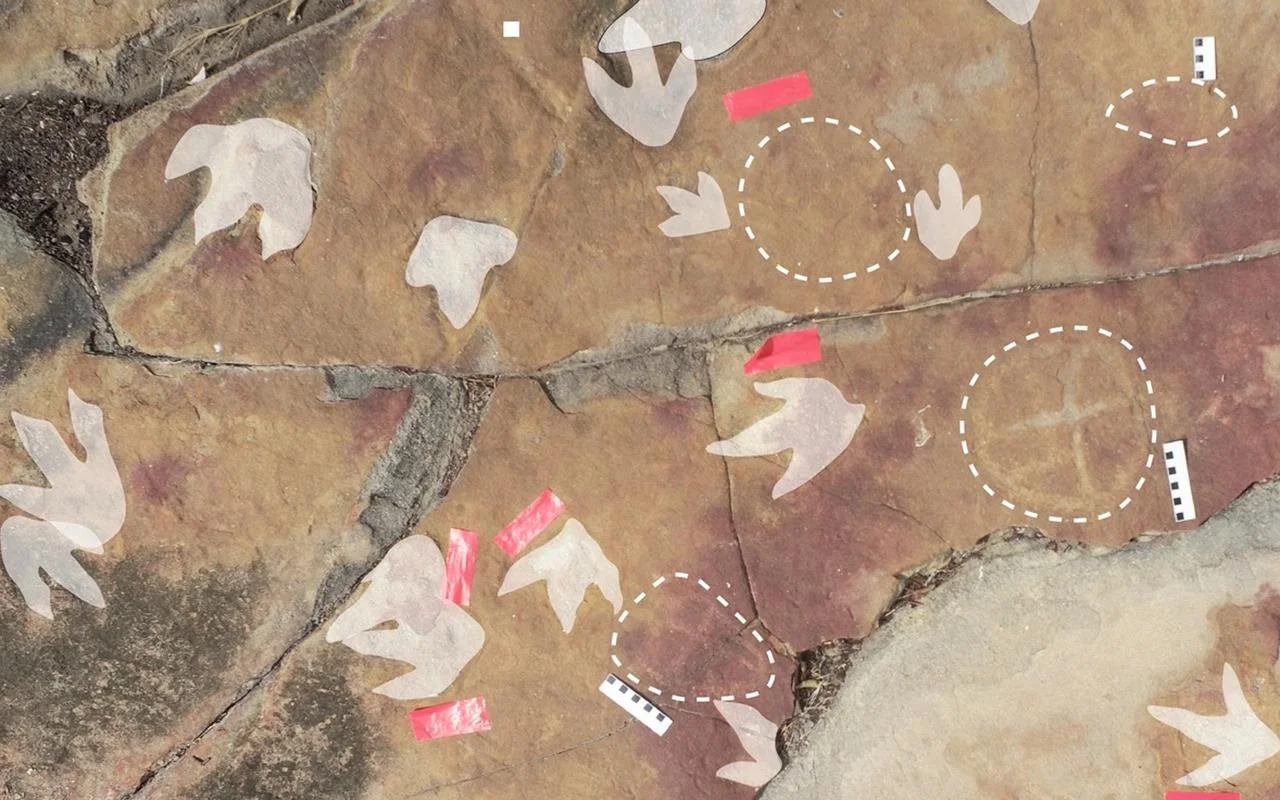
This area is like no other. Archaeological research revealed the presence of mysterious prehistoric art in stone (rock engravings), and traces of dinosaurs were also found in the same place.
Serrote do Lettreiro is located in a rural area in the state of Paraíba, Sousa state, in northeastern Brazil. Dinosaur traces are known, but now a study has been published in the journal Scientific reports It highlighted new details of previously unexplored petroglyphs found in the same rock group as ancient reptile footprints.
This amazing convergence of fossil and archaeological evidence is extremely rare and promises to make the site known as Serota do Letreiro (“Hill of the Tablets” in Greek) a popular destination for scientists who want to learn more about ancient human civilization and the history of dinosaurs. Or both.
Cerote de Letrero area
Cerote de Letrero consists of three large outcropping rocks with a total area of 5,739 m22 It is characterized by an excellent juxtaposition of fossil and archaeological evidence, according to the study.
Previous studies showed that dinosaur footprints came from creatures that lived during the Early Cretaceous period, that is, between 145 and 100 million years ago. They are found alongside numerous petroglyphs, a type of stone carving created by removing portions of the surface using tools such as chisels.
Researchers have identified sauropods (the largest animal that ever lived), theropods, and iguanodonts among the creatures to which the fossilized footprints are claimed to belong.

Petroglyphs and dinosaur fossils
“The main discovery of the study is a combination of petroglyphs (rock art) and dinosaur fossils in the area, which is not found in any archaeological or paleontological site in the world.”Leonardo Troiano, an archaeologist at Brazil's National Institute of Historical and Artistic Heritage (IPHAN) and lead author of the study, told Newsweek.
Although the area is surrounded by fossils and rocks, there is a spot next to it that has not been described before. The first reports of dinosaur footprints in the Susa area date back to the early 1900sSh a century. However, paleontological findings became the subject of scientific research when Italian priest and researcher Giuseppe Leonardi began research in the area in the 1970s.
Leonardi is the man who officially discovered several fossil sites, including Cerote do Letrero, during the 1970s. However, his research focuses on the paleontological aspects of the site, ignoring the petroglyphs scattered throughout the area.
“He did not pay much attention to the petroglyphs, which he refers to simply as ‘carvings of the Kariri Indians’, insisting on focusing on the ruins of the Sousse region.” Troiano explained.
Since then, the petroglyphs at this particular place have barely been mentioned in the literature. Before the latest study, no comprehensive analysis of the petroglyphs had been done, and researchers had never linked the presence of dinosaur footprints to rock art.
The relationship between petroglyphs and dinosaur tracks
In an attempt to learn more, Troiano and his colleagues conducted research in the Cerote do Letrero area, taking aerial photographs with drones. The research resulted in the identification of “many” rock engravings and more dinosaur footprints, as well as revealing the close relationship between them.
“We were the first to notice the close relationship between petroglyphs and footprints,” Troiano explained. “We continued to explore and discovered, in addition to the outer part, on the rocky ledge that Leonardi examined, as well as several dinosaur footprints and nearly 100 petroglyphs on two other relief volumes. We realized that it was necessary to declare and mark the area, as it is a vulnerable area “At risk due to intense mining activity that may lead to its destruction.”

Traces of ornithopods, theropods, and sauropods
The Susa area has ideal conditions for preserving prints, but not bones. As a result, few fossilized dinosaur bones have been found in the area, in contrast to many fossilized dinosaur footprints.
Therefore, it is difficult to determine what type of dinosaur created the footprints. However, researchers report that the tracks were created by ornithopods, theriopods and sauropods.
Ornithopods were a group of herbivores, and one of the most dominant lineages of dinosaurs. They started out as small, bipedal grazing herbivores, and over time, their size and numbers increased.
Theropods, on the other hand, were carnivorous dinosaurs, ranging in size from the 0.60 cm Microraptor to the 12.20 m Tyrannosaurus.
The group of sauropod dinosaurs included the largest animals to ever inhabit and walk the Earth, species such as titanosaurs. These dinosaurs had very long necks, long tails, small heads, and four thick, heavy legs. Among the newly identified footprints in the study were those of a herd of dinosaurs.

Mysterious geometric shapes on the rocks
The petroglyphs include geometric shapes whose meaning is not understood. “We may never find out,” Troiano says. “Since the civilization that created these symbols is so ancient, the secrets of their visual communication code have now been lost. However, we know, based on dating from the area, that the petroglyphs must have been created between 3,000 and 9,000 years ago.” “. Interestingly, all the authors of the study point to the relationship between footprints and petroglyphs.
“The rock symbols remind us of The first images that form in the brain after taking hallucinogens», Troiano noted. “This, along with other factors, leads me to believe that the creation of these symbols was part of a separate ritual, and the site was chosen because of the presence of footprints, so it had special significance for these people.”
Who created the petroglyphs?
Traditionally, science has neglected and belittled the history of Native Americans, ruling out the possibility of their significant contributions to civilization, because their “simple or primitive minds” — according to scholars of the past — “were not able to appreciate or investigate” fossils.
As for the practical implications, the study shows that the Native Americans discovered the fossils and applied their own way to interpret this natural phenomenon, and that the fossils had special importance for the Native Americans. This is evidenced by the fact that they devoted themselves to creating numerous petroglyphs around the footprints, according to Troiano.
The results of the study indicate that fossils have much greater cultural importance than we imagine
“As a practical consequence of this fact, fossils can now be recognized as cultural heritage of Brazil, and not just as objects of scientific interest.”“, points out Troiano. “It is amazing to discover ancient rock art alongside beautifully preserved dinosaur footprints, all unimaginably ancient.”
“Now, we plan to excavate the site and surrounding area as soon as possible, and we may be able to gather more information about the ancient group of people who created the petroglyphs.” finish.

“Total alcohol fanatic. Coffee junkie. Amateur twitter evangelist. Wannabe zombie enthusiast.”





More Stories
Is this what the PS5 Pro will look like? (Image)
Finally, Windows 11 24H2 update significantly boosts AMD Ryzen – Windows 11 performance
Heart Surgeon Reveals The 4 Things He ‘Totally Avoids’ In His Life